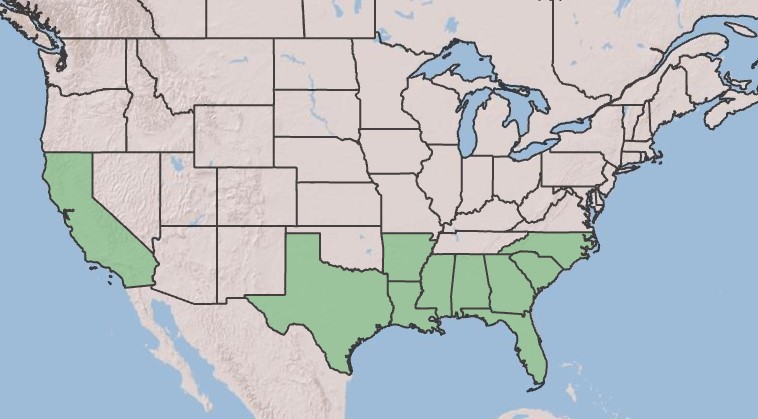Difference between revisions of "Prunus caroliniana"
HaleighJoM (talk | contribs) |
(→Ecology) |
||
| Line 25: | Line 25: | ||
==Distribution== | ==Distribution== | ||
==Ecology== | ==Ecology== | ||
| − | + | ===Habitat=== | |
| + | ''P. caroliniana'' has been found in natural communities such as floodplain forests, edges of live oak hammocks, pine-oak woodlands, thickets, magnolia-quercus-aesculus hammocks, mixed upland woodlands, wooded bluffs, scrub habitats, and old sand dunes. It can also be found in developed areas prone to more human disturbance such as vacant lots, fencerows, forest edges, and along railroad tracks. ''P. caroliniana'' will usually be found as an understory tree in sandy loam or loamy sand.<ref name = fsu> Florida State University Robert K. Godfrey Herbarium database. URL: http://herbarium.bio.fsu.edu. Last accessed: June 2023. Collectors: Frank Almeda, Loran C. Anderson, Kathy Craddock Burks, George R. Cooley, Robert K. Godfrey, O. Lakela, Arthur Stanley Pease, David Printiss, States and counties: Florida: Bay, Calhoun, Franklin, Hernando, Jefferson, Leon, Liberty, Madison, Okaloosa, Wakulla, Walton, and Washington. Georgia: Grady.</ref> | ||
| + | |||
| + | Species associated with ''P. caroliniana'' include ''[[Magnolia ashei]]''.<ref name=fsu/> | ||
<!--===Phenology===--> <!--Timing off flowering, fruiting, seed dispersal, and environmental triggers. Cite PanFlora website if appropriate: http://www.gilnelson.com/PanFlora/ --> | <!--===Phenology===--> <!--Timing off flowering, fruiting, seed dispersal, and environmental triggers. Cite PanFlora website if appropriate: http://www.gilnelson.com/PanFlora/ --> | ||
<!--===Seed dispersal===--> | <!--===Seed dispersal===--> | ||
Revision as of 14:37, 20 June 2023
| Prunus caroliniana | |
|---|---|
| Scientific classification | |
| Kingdom: | Plantae |
| Division: | Magnoliophyta - Flowering plants |
| Class: | Magnoliopsida - Dicotyledons |
| Order: | Rosales |
| Family: | Rosaceae |
| Genus: | Prunus |
| Species: | P. caroliniana |
| Binomial name | |
| Prunus caroliniana Aiton | |

| |
| Natural range of Prunus caroliniana from USDA NRCS [1]. | |
Common name: Carolina laurelcherry
Contents
Taxonomic Notes
Synonyms:
Description
Distribution
Ecology
Habitat
P. caroliniana has been found in natural communities such as floodplain forests, edges of live oak hammocks, pine-oak woodlands, thickets, magnolia-quercus-aesculus hammocks, mixed upland woodlands, wooded bluffs, scrub habitats, and old sand dunes. It can also be found in developed areas prone to more human disturbance such as vacant lots, fencerows, forest edges, and along railroad tracks. P. caroliniana will usually be found as an understory tree in sandy loam or loamy sand.[1]
Species associated with P. caroliniana include Magnolia ashei.[1]
Conservation, cultivation, and restoration
Cultural use
Photo Gallery
References and notes
- ↑ 1.0 1.1 Florida State University Robert K. Godfrey Herbarium database. URL: http://herbarium.bio.fsu.edu. Last accessed: June 2023. Collectors: Frank Almeda, Loran C. Anderson, Kathy Craddock Burks, George R. Cooley, Robert K. Godfrey, O. Lakela, Arthur Stanley Pease, David Printiss, States and counties: Florida: Bay, Calhoun, Franklin, Hernando, Jefferson, Leon, Liberty, Madison, Okaloosa, Wakulla, Walton, and Washington. Georgia: Grady.